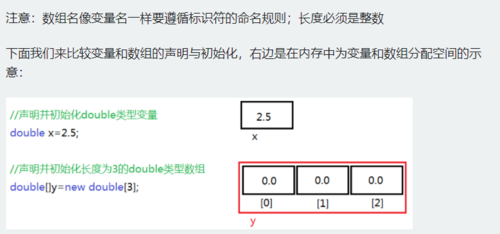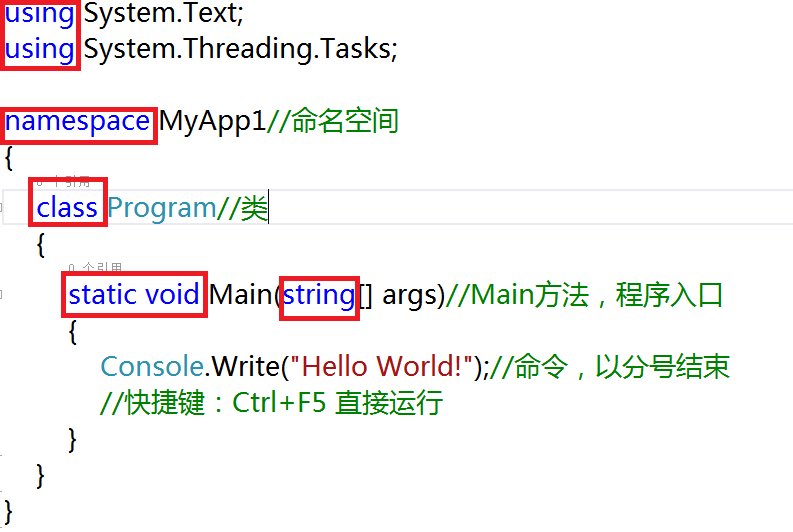-
单行注释的符号是2条斜线 //(请注意斜线的方向),2条斜线右侧的内容就是注释,左侧的代码不会受影响。
多行注释以“/*”开始,以“*/”结束,之间的内容就是注释,可以包含多行。
文档注释写在类、方法或属性(以后会学到)的前面,它的符号是3条斜线“///”
查看全部 -
启动调试按钮快捷键:F5
查看全部 -
二维数组的声明:
int[,] arr = new int[2,3]; //包含2个一维数组,每个一维数组包含3个变量,总共2*3=6个数组元素
二维数组的赋值和打印:
arr[1,0] = 28; //二维数组元素有2个索引,都是从0开始,以arr数组为例,元素索引从[0,0]到[1,2]Console.Write( arr[1,0] );
arr[1,0] = 28; //二维数组元素有2个索引,都是从0开始,以arr数组为例,元素索引从[0,0]到[1,2]Console.Write( arr[1,0] );查看全部 -
foreach的用法:
foreach(数据类型 迭代变量名 in 数组名){
使用迭代变量
}
例:foreach(int x in num){
x++;
}
注:在foreach中不可对数组中的元素进行修改
查看全部 -
声明并初始化数组的语法:
数据类型[] 数组名 = new 数据类型[]{初始值1,初始值2,...初始值3};
数组的 Length 属性返回数组的长度,即数组元素的个数。
using System;
using System.Collections.Generic;
using System.Text;
namespace Test
{
class Program
{
static void Main(string[] args)
{
//请在这里完善代码
string[] FiveMan = new string[]{"关羽","张飞","赵云","马超","黄忠"};
for(int i=0;i<FiveMan.Length;i++){
Console.Write(FiveMan[i]+",");
}
}
}
}
查看全部 -
数组的声明和初始化:
数据类型[ ]数组名 = new 数据类型 [长度];
例:int [ ] num = new int[3]{1,2,3};
int [ ] num = new int[ ]{1,2,,3};
int [ ] num = {1,2,3};
错误写法: int [ ] num = new int [3]{1,2};
数组初始长度和实际长度不符错误。
查看全部 -
using System;
using System.Collections.Generic;
using System.Text;
namespace Test
{
class Program
{
static void Main(string[] args)
{//请完善代码
for(int y=1;y<=7;y++){ //y表示行
for(int x=1;x<=7;x++){ //x表示列
if(x==y||x+y== 8){
Console.Write("O");
}
else{
Console.Write(".");
}
}
Console.WriteLine(); //内循环结束换行
}
}
}
}
关键是找到行和列数之间的关系,在什么情况下需要如何输出,(x==y||x+y== 8)。循环起始值如果为1,则x+y==8,起始值为0,则x+y==7。
查看全部 -
1、C#中的关键字都是小写的
2、Console.Write()执行完后不换行
3、Console.WriteLine()执行往后要换行
查看全部 -
string[] names = new string[] { "景珍", "林惠洋", "成蓉", "洪南昌", "龙玉民", "单江开", "田武山", "王三明" };
int[] score = new int[] { 90, 65, 88, 70, 46, 81, 100, 68 };
//1、平均分
int zongfen = 0;
for(int i = 0; i < score.Length; i++)
{
zongfen += score[i];
}
int avg = zongfen / score.Length;
//2、高于品均分同学
string name = "";
for (int i = 0; i < score.Length; i++)
{
if (score[i] > avg)
{
name += names[i] + " ";
}
}
Console.WriteLine("平均分是" + avg + ",高于平均分的有:");
Console.Write(name);
查看全部 -
using System;
using System.Collections.Generic;
using System.Text;
namespace Test
{
class Program
{
static void Main(string[] args)
{
//请完善代码
for(int x = 1;x<=7;x++){
for(int y = 7;y>=1;y--){
if(x+y == 8 || x == y)
Console.Write("o");
else{
Console.Write(".");
}
}
Console.WriteLine();
}
}
}
}
查看全部 -
数据类型[ ] 数组名 = new 数据类型[长度];
 查看全部
查看全部 -
函数里面的++和在外面的相反,外面,++在后,加后值
查看全部 -
C#中最常用的三种循环结构,下面我们小小总结一下:
 查看全部
查看全部 -

关键字 class ,这个关键字的用途是声明类。比如上面例子中,类名叫做Program。
关键字 namespace ,这个关键字的用途是声明“命名空间”。比如上面例子中,命名空间叫做MyApp1。
关键字 using ,这个关键字的用途是导入命名空间。比如这句:
using System.Text;作用是导入System.Text命名空间中的类。关键字 static (静态的)、 void (无返回值)、 string (字符串类型)。常常在Main()方法的声明中看到:
static void Main(string[] args)Main() 方法是 C# 中的特殊方法,是程序的入口,就是说,如果没有 Main ()方法,程序就无法启动。
查看全部 -
条件表达式 ? 分支1 : 分支2查看全部
举报









